Last Updated on April 4, 2024
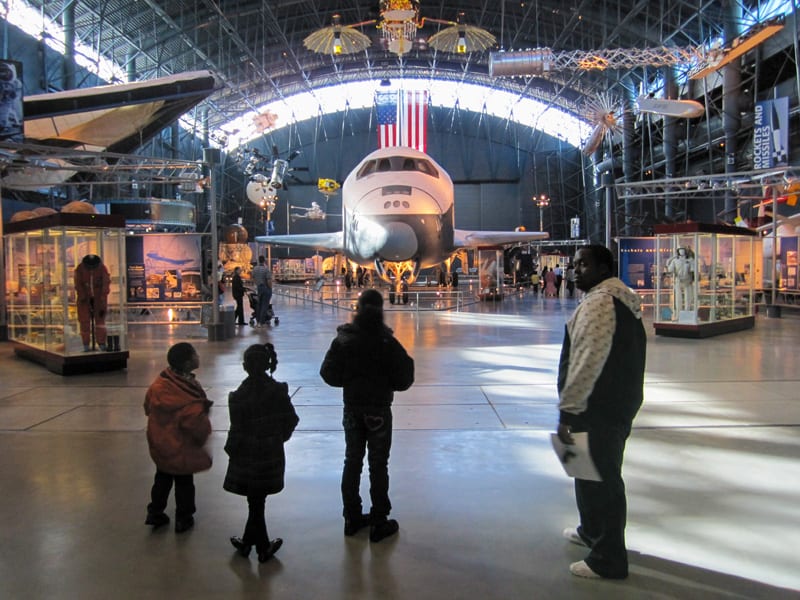
Estimated reading time: 14 minutes
By Jim Ferri
The National Air and Space Museum, adjacent to Washington DC’s Dulles Airport, is incredible.
In fact, I had heard so much about it that when flying to London, I scheduled a connection through Dulles to visit it. Nevertheless, although I allotted several hours between flights to visit the museum, I could have used an additional hour or two. Or better, an extra day to marvel at some of the world’s most significant objects.
The Dulles facility is an offspring of the famous National Air and Space Museum on the National Mall near L’Enfant Plaza in downtown Washington, DC. I don’t know anyone who has ever visited the DC museum and hasn’t been wowed by the place. After all, it contains the Wright brother’s original plane, Lindbergh’s Spirit of St. Louis, and the Apollo 11 command module – and that’s barely scratching the surface.
Together the two facilities contain the most extensive collection of aviation and space artifacts on earth. It’s also the most visited museum facility in the world and one of the most popular museums in the U.S.
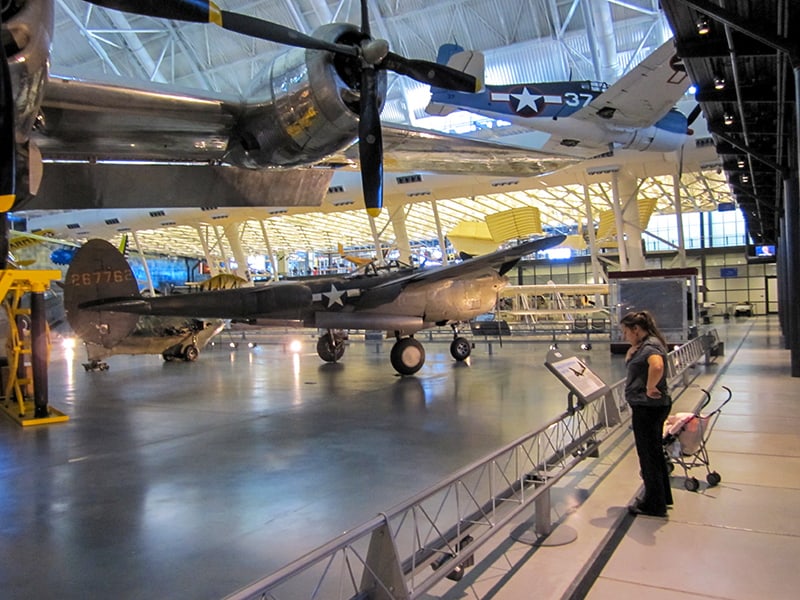
The Bulk of the Collection
The Dulles museum, however, differs from its mother on the DC Mall and its huge hangers hold the bulk of the museum’s collection. Its displays include thousands of aviation and space artifacts since its hangers allow it to have much larger aircraft and spacecraft than the DC museum, such as the Space Shuttle Discovery. In addition, in Dulles, there’s also a restoration hanger.
And lest we forget, Dulles is an airport, so you can fly into the facility, something that’s a bit challenging to do on the National Mall.
Best yet, admission is free at both locations, although a timed ticket (book online) is required for the downtown location. The museum’s peak times are March-August, holidays, weekends, and special event days. You’ll need to allow extra time for entry and parking at those times.
The Steven F. Udvar-Hazy Center
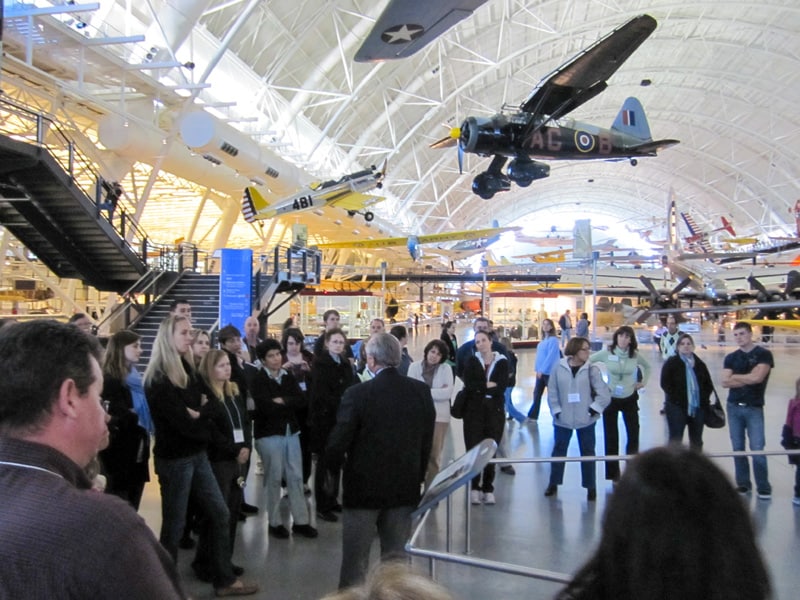
The Steven F Udvar-Hazy Center is an aeronautical fantasy land. But, even if you don’t have an interest in aircraft, you’ll enjoy the museum. That’s because it really makes a connection with history. It brings you close to many things you have only read about or seen on TV or in the movies.
Before I visited, I never thought the National Air and Space Museum Dulles would be as large as it is. The facility itself is 17 acres (760,000 square feet; 7.1 ha); the main hanger is 10 stories high and the length of three football fields.
This is a place with lots of visual impacts. As you walk through the museum’s entrance, you immediately see the Space Shuttle Discovery in front of you. It’s a mesmerizing sight with the several satellites about it, some looking like candelabras in a gigantic hotel ballroom.
Look about, and you see all sorts of planes parked on the floor and hanging in different positions from the ceiling above.
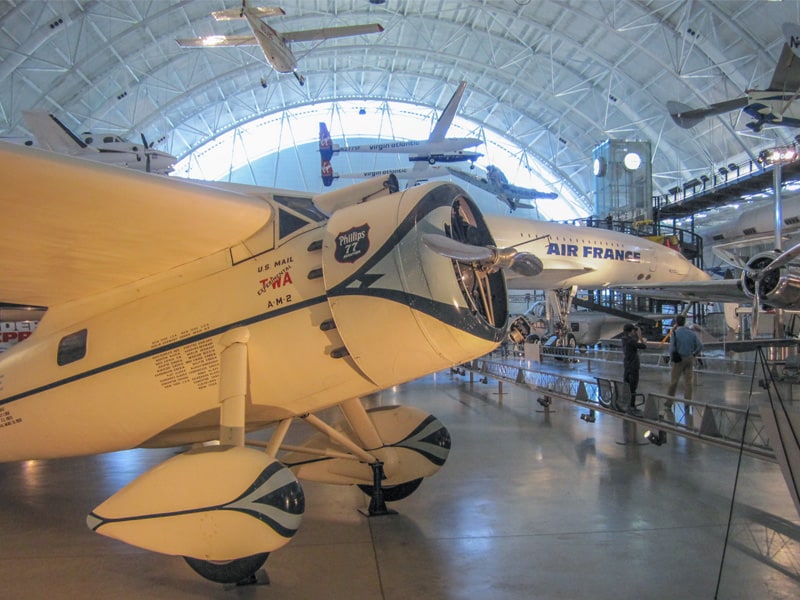
Huge and Tiny Airplanes at the Air & Space Museum Dulles
Walking about, I found the different planes and aviation/space memorabilia incredible, not just because of their types but also because they varied so much in size.
I found World War II fighters diving down from above as if on a strafing run. In another area, there were helicopters and lots of experimental planes. There was a beautiful, swan-like Air France Concorde and a small Japanese aircraft designed to be launched from a submarine.
There was even an acrobatic airplane so small I felt I could fold it and put it in my luggage.
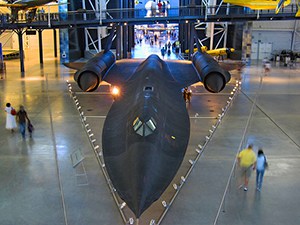
When you visit, go for a walk on the skywalks, four stories high. They provide close-up views of just about everything that’s not on the ground.
However, on the ground of the National Air and Space Museum Dulles, don’t miss the Lockheed SR-71 Blackbird, the super-secret spy plane from the Cold War era. The world’s fastest jet-propelled aircraft, it flew faster than a bullet at 2,200 mph and more than 16 miles high. It could fly from New York to London in less than two hours and Los Angeles to Washington in 64 min.
Its demise was due to the expense factor (a whopping $85,000 per hour to operate) and technology or, more accurately, the lack of it. Since the Blackbird had no data link, it must return to land to process its film. Today, that’s all done instantly from the air.
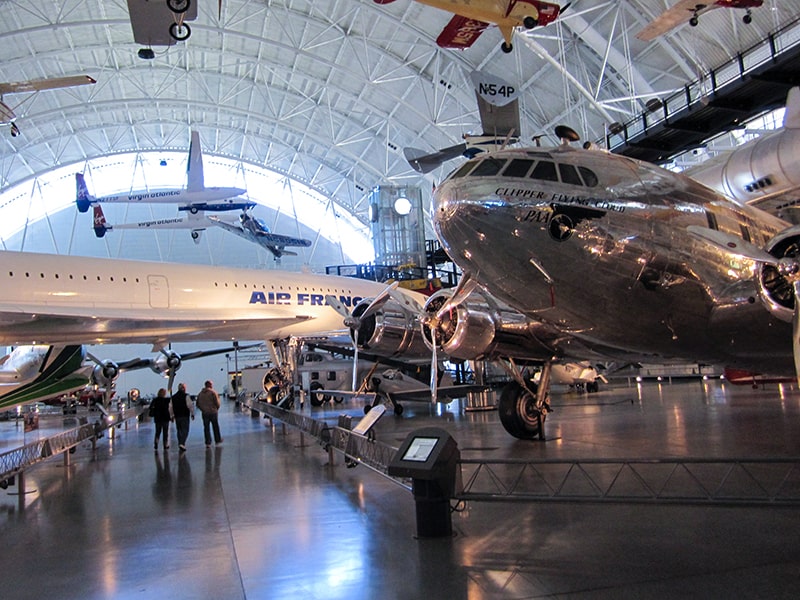
23 Fantastic Sections
You can just wander about the National Air and Space Museum Dulles and you’ll discover many amazing things. Or you can plan your visit based on your interest. It’s easy to arrange a visit since the Steven F. Udvar-Hazy Center is has seperate 23 sections.
The first section, Vertical Flight, pertains to the history of helicopters, from the first rotary-wing aircraft (called autogiro) to the XV-15.
The Aerobic Flight Section includes the planes flown by civilian pilots for fun, competition, or performance. In addition, military pilots use aerobatic flight for combat tactics. Aircraft used for aerobatics range from barnstormer-style biplanes to the latest military fighter jets.
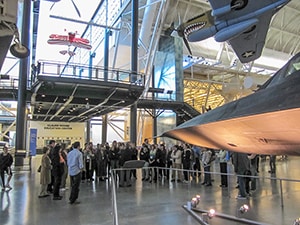
The second, Sport Aviation, is about flying for pleasure, and includes gliders, sailplanes, hang gliders, ultralights, etc. Finally, General Aviation focuses on all civilian aircraft not flown by commercial carriers or the military. Interestingly, they account for approximately 75% of all flight operations in the US.
Business Aviation focuses on company-owned, chartered, or leased aircraft that fly company personnel around the country or overseas.
Commercial Aviation takes you through the history of commercial air transportation through its displays ranging from a Junkers JU 52/3M, a famous German airliner of the 1930s, to an Air France Concorde.
The Pre-1920 Aviation focuses on the first decade after 1903 and the airplanes of World War I. This is the period when human flight began to come of age.
The focus of the Ultralight Aircraft section begins with the birth of ultralight flight in 1922 when gliding enthusiasts tested gliders propelled by small engines. The idea disappeared until, as you’ll see, a few hang glider pilots began experimenting with small engines they called “glide extenders” during the late 1960s.
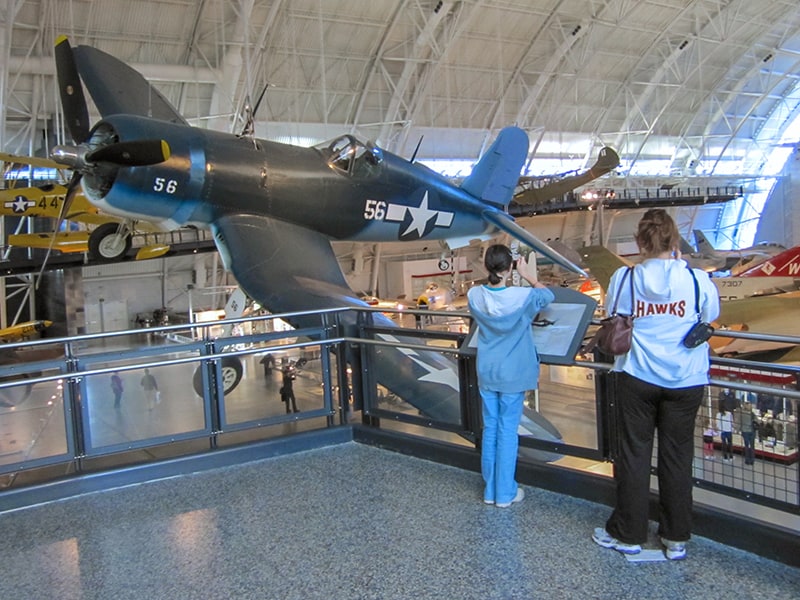
Military Sections
The Interwar Military Aviation section of the National Air and Space Museum Dulles contains many one-of-a-kind and sole-surviving aircraft. It shows how the airplane emerged from World War I and was recognized for its potential use as a military weapon in the 1920s and 1930s. In the US, military aviators then worked to develop the airplane’s ultimate role in American defense.
There are also sections on World War 2 aviation, Korea, and Vietnam. You can walk right up to the Enola Gay, the B-29 that dropped the first atomic bomb on Japan in World War II. It was amazing to me since I always thought that this B-29 Superfortress was somehow larger than it was. Evidently, the word “Superfortress” fueled my childhood imagination too much.
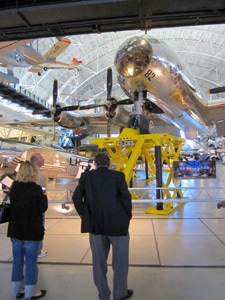
Cold War Aviation focuses on the role of aerial reconnaissance in the post-World War II competition between superpowers. One of the jewels in the collection is the stealthy Lockheed SR-71 Blackbird, the super-secret spy plane from the Cold War era. The world’s fastest jet-propelled aircraft was finally pulled from service for two reasons. One was the expense factor – it cost $85,000 per hour to operate – but also because it had no digital data link. After the plane landed, its film underwent processing and before being sent to commanders. Today that’s all done instantly from the air.
Modern Military Aviation follows the development of airplanes following World War 2. In this section, you view the modern aircraft that have taken the place of the vast aerial armadas required in past World Wars.
World War 2 German Aviation focuses on the Luftwaffe’s principal role in the German Blitzkrieg conquest of almost all of Western Europe. It also focuses on the effects of faulty military strategy and mismanagement of aircraft development programs.
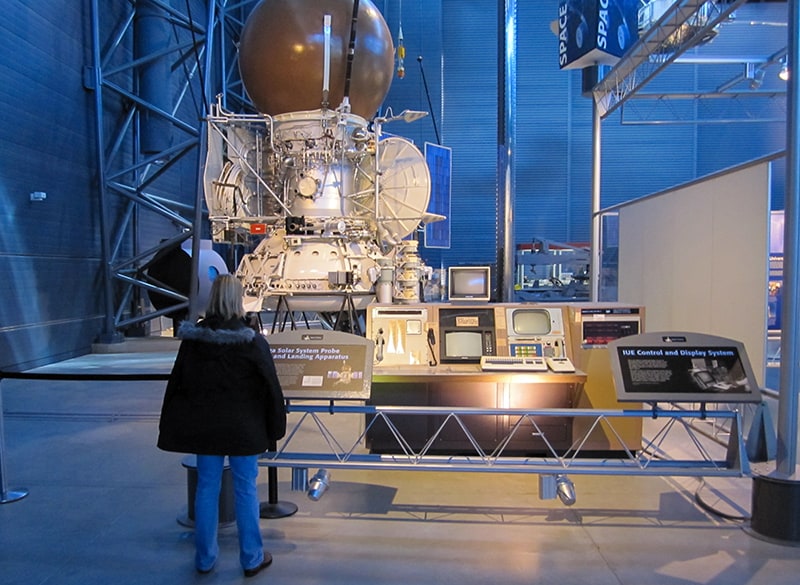
Space Exploration
The Human Spaceflight section of the National Air and Space Museum Dulles shows how spaceflight is one of the outstanding achievements of the modern age. Here you’ll learn how Astronauts, some aboard the Space Shuttle Discovery, have floated in open space, delivered satellites, conducted laboratory experiments, repaired space telescopes, and built a space station. You’ll learn a lot about space exploration.
Another section, Space Science, is a relatively young field, so it focuses only on the latter half of the 20th century. Objects on display include vehicles (balloons, sounding rockets, satellites, space probes, orbiters, landers), the scientific instruments they carried, ground-based instruments, and other examples of technology.
In the tense years of the Cold War, spacecraft known as applications satellites evolved down two paths: one devoted to national security needs, the other to civilian interests. The Applications Satellites section demonstrates their history and unique benefits.
Beginning in the 1920s, visionaries in the United States, Germany, the Soviet Union, and elsewhere began developing liquid-fuel rockets with an eye toward space travel. Within a few decades, as you’ll see in the Rockets and Missiles Section, rockets and missiles had begun to alter the 20th century.
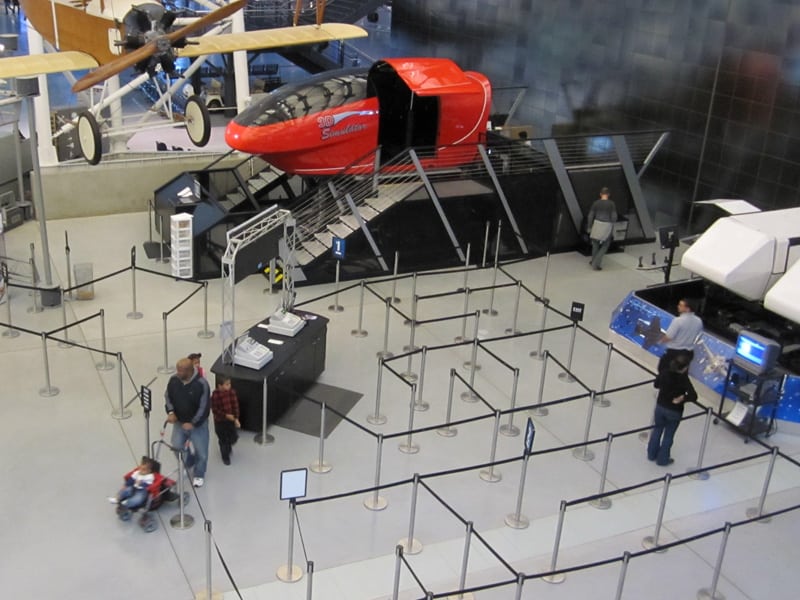
Ride In a Simulator. Visit the IMAX Theater, Grab a Bite to Eat
There are also simulators in the National Air and Space Museum Dulles you can take for a ride. There’s also an IMAX Theater, multimedia classrooms/learning labs, and a museum store.
When it comes time to take a break, head for the Museum’s cafeteria. It serves hamburgers, hotdogs, sodas, wine, and beer.
In addition, you can view planes approaching the airport from the Museum’s control / observation tower and listen to communications between them and Dulles’s tower across the runway.
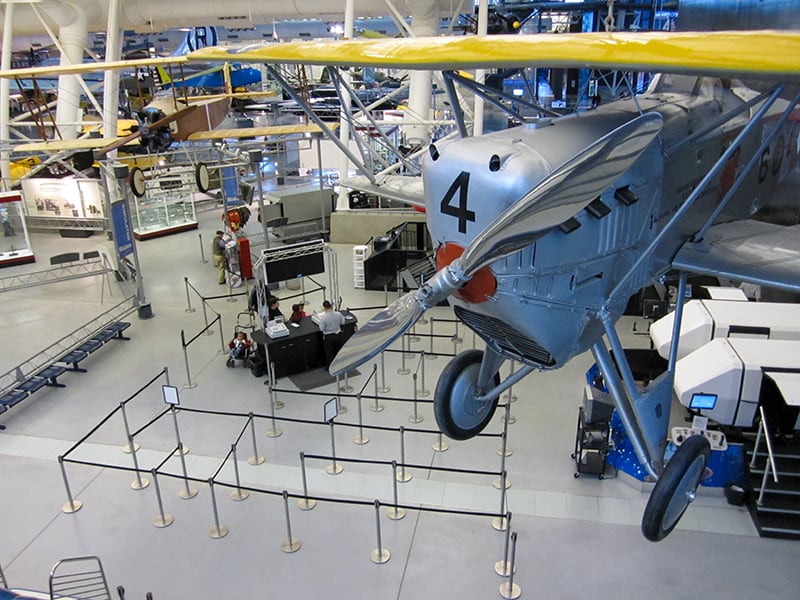
Visiting School Groups at the Air & Space Museum Dulles
The National Air and Space Museum Dulles is incredibly user-friendly and offers several unique programs. It provides field trips for grades K-12 at both of its locations, as well as virtual programs. Programs range from Paper Airplane Design to Flight School Math and Mission to Mars.
Special free inquiry-based programs are also available for school groups, homeschool groups, and community-based organizations serving youth that meet the minimum program requirements. These programs align with the Next Generation Science Standards and explore topics in science, technology, engineering, art, and math (STEAM). Teachers use a combination of demonstrations, experiments, and hands-on activities to assist in the learning process. Groups must reserve programs at least three weeks in advance.
For more information, email [email protected].
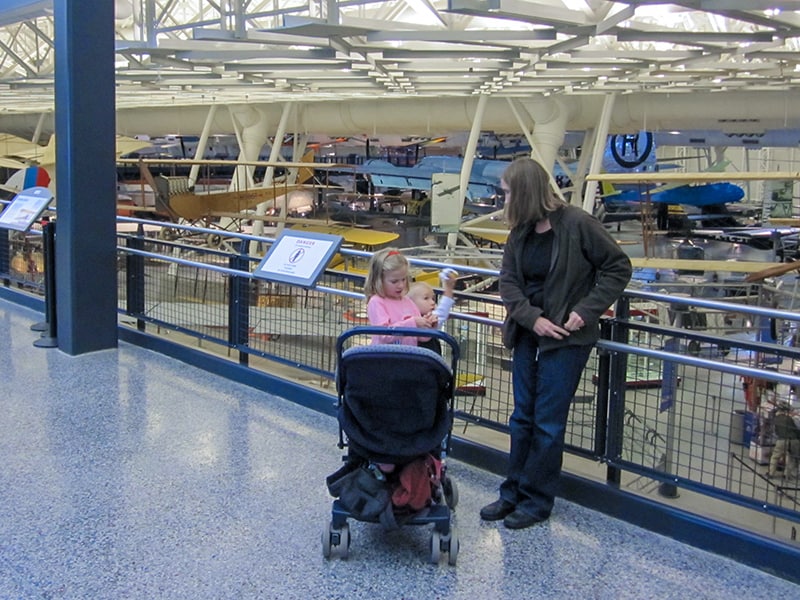
Accessibility at the Air & Space Museum Dulles
Advance reservations are not required for self-guided visits or participating in walk-in programs. In addition, many trained tour guides are give tours to children and adults with various disabilities.
The National Air and Space Museum Dulles is accessible to all visitors, and Visitors are welcome to bring their own mobility devices. Exterior access ramps and interior elevators are available.
A limited number of standard and bariatric wheelchairs are available for use while visiting the Museum and are provided on a first-come, first-served basis. You’ll find them to the right after entering the Udvar-Hazy Center.
For visitors who are blind or have low vision, audio-described, docent-led tours and discovery stations with models and tactile components are available. Braille and Tactile Guides are available at the entrance of the Museum.
While service animals are welcome at the Museum, emotional support, therapy, comfort, or companion animals are not permitted.
A two-week advanced notice is requested to reserve an individual program or accessibility services. When requesting an accessibility service, please specify the mode of communication required (e.g., for sign language: ASL, PSE, or Signed English).
The National Air and Space Museum Dulles’ location in the Virginia countryside makes it less accessible to visitors in downtown Washington, DC. But it still draws quite a vast number of visitors. And keeps them wandering around the extensive display for quite some time. You’ll be doing yourself a favor if you’re one of them next time you’re in Washington.
You may also enjoy: Road Trip: Kennedy Space Center from Orlando / 3 Unique (and Great) Museums in Washington, DC / The Top 10 Places in Washington, DC
If You Go:
Steven F. Udvar-Hazy Center
14390 Air and Space Museum Parkway
Chantilly, Virginia 20151
(The Center is south of Washington Dulles International Airport along Route 28, about 1/2 mile north of the intersection of Routes 28 and 50.)
http://www.nasm.si.edu/udvarhazy/
(703) 572-4118
Open: every day except December 25 from 10:00 am to 5:30 pm.
Admission: free and no tickets are required (timed-entry passes are required at the museum on the National Mall, however)
Parking: $15 (after 4pm, parking is free). Payment is made inside at self-pay stations and at the exit gates. Credit and debit cards are accepted at all payment stations. Those paying cash must exit via the staffed booths (right two lanes).
Public Transportation
Depending on your point of departure, you may need to use a combination of public transportation options to reach the Udvar-Hazy Center.
From the Museum in DC
- Walk south two blocks to the L’Enfant Plaza or Smithsonian Metro stations.
- Take Metro Silver Line to the Innovation Center station. Fares are paid with Metrorail passes or SmarTrip cards.
- Transfer to Fairfax Connector Bus No. 983. Buses run every 25 minutes during peak times and every hour during non-peak times and weekends. Bus fares are paid with a SmarTrip card or cash. Bus drivers do not carry change.
- Exit bus at Steven F. Udvar-Hazy Center stop.
The trip takes approximately 1½ hours.
From Washington Dulles International Airport to the Udvar-Hazy Center in VA
From Ground Transportation bay #5E (lower level exit #6), take Fairfax Connector No. 983, one stop to Steven F. Udvar-Hazy Center. Buses run every 25 minutes during peak times and every hour during non-peak times and weekends. Bus fares are paid with a SmarTrip card or cash (drivers do not carry change). The bus ride from Dulles Airport takes approximately 25 minutes.
From Northern Virginia
Fairfax Connector provides connecting bus service from the Silver Line’s Innovation Center Metro station. Bus fares are paid with a SmarTrip card or cash (drivers do not carry change). Schedules, fares, and information are available on the Fairfax Connector No. 983 website. Buses run every 25 minutes during peak times and every hour during non-peak times and weekends. Trips between Innovation Center and the Udvar-Hazy Center take about 12-15 minutes.
The Washington Flyer Taxi Service also provides private bus service between select Metrorail stations and Washington Dulles International Airport.

It’s been closed for a year
Hi Charlie,
Your’re correct. Like so many other museums about Washington it has been temporarily closed due to the pandemic. But like the others, it too will reopen sometime in the future when we’re out of this mess.
Great article …thank you! The beauty also of museum is flying in to IAD and taking freebus to museum! Great day trip for “AV-GEEKS”! I had to cancel due to covid closure but now thanks to this article I shall plan my trip to the museum again!
Hi Kristen – it’s a great museum! I tell people to do as I did, and reroute your flight through Dulles to spend a few hours in the museum. It contains incredible pieces of history – far beyond what you can see in the Air and Space Museum in downtown Washington.
Jim